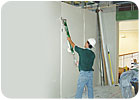
To look at the evolution of drywall finishing tools, we should first look at the evolution of the product they would eventually be used on. In the 19th century, the construction industry wanted to come up with a wall surface that was high quality, durable and could be painted over and over again. This product would have to last as long as the home stayed standing, so along came the lath and plaster system. The contractor would nail up thousands of wood slats, lay down a basecoat of lime plaster with a hawk and trowel, and then apply a finish coat with the same tools. The wood lath would eventually be replaced by metal lath and metal lath by rock lath as a base in the 1930s.
These pieces of gypsum rock came in 16 inches by 48 inches by 3/8 inches thick. The plasterer would again apply the base and finish coat of plaster over the rock lath. You would still get a high quality wall but this method was very labor intensive and the materials used were still expensive on a square foot basis. Another problem was the finished product was somewhat brittle and could crack, which required expensive repairs. In the late 1900s, lime-based plaster, which could take days to dry and weeks to cure, was replaced by gypsum-based plaster that took a fraction of the time to dry and cure.
In the beginning
Drywall (gypsum board) was introduced to the building industry in 1917 as a new construction material but it didn’t take off. This product, invented in 1916 by a large manufacturer, was lighter and came in larger sheets than the rock lath. The product had a lightweight gypsum core that was surrounded by back-and-face paper. The thickness of the drywall sheets were 1/2 and 5/8 inch, and could be manufactured in 4 feet wide by 8 feet sheets that were applied to the wood studs with fasteners. Instead of covering the whole sheet with base and finish coats like a plasterer, the applier would only have to tape and finish coat the seams and angles. Since this process was much faster than the plastering method, contractors could save a great deal of labor and material costs. In addition, the builders could depend on this part of the construction phase to be completed much sooner. But the application of attaching the wooden slats to the wooden studs, then plastering the lath, would be the market mainstay for approximately another 23 years.That all changed during World War II. With an urgent need for military structures, ranging from barracks to whole bases, the government was faced with a shortage of both labor and material and desperate to find a faster and cheaper way to build. Thus, the demand for drywall was initiated.
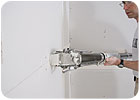
3
Originally, this was a stopgap replacement for plaster but it didn’t turn out that way. The demand only increased with the return of the soldiers after World War II. Many builders who had gotten used to slapping up drywall were suddenly reluctant to go back to the labor and expense of plastering. The post war residential building market boomed with the introduction of tract housing developments. The finishers could complete their work in a few days, since it usually took only one day per coat to dry.With the invention of drywall came the invention of tools for the drywall finisher to complete his work. Initially, the same hawk and trowel that the plasterers used for the lath and plaster method was used to tape and coat the seams on board. These tools were heavy and ergonomically difficult to use. To make the tools lighter, the drywall pan and knife were invented. Not only did they weigh less but they also created less strain on the finisher’s arms. Hand tools were sufficient for the smaller volumes of demanded drywall. But with the larger demand of drywall to be finished in 1940 and after, it was more important that the drywall finisher increase their finishing speed.
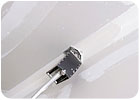
Automatic
This need for speed prompted a California company to invent the first automatic tools in 1939. These tools were much faster to use than the hawk and trowel or pan and knife method but were physically more demanding. For taping the seams and angles you would use a tube (automatic taper) full of joint compound with paper tape attached that could apply both products all in one motion. Over a four or more day period, the finisher would use the mechanical boxes for fill and skim coating the seams and butts, run the angles with a squeeze box and angle head, run the nail spotter over the fasteners, until the projects were completed.The upside was these tools were faster and more efficient. The downside was the wear and tear on the finisher using them was much higher. The contractor would fill these tools by using a hand pump, then finish by pushing on each finishing tool to get the joint compound onto the wall.
For the next 55 years, drywall finishers could pick from hand tools or automatic tools for their finishing needs. Many manufacturers produced their version of those same tools. Also during this time period, there were other types of tools and systems invented that were brought to the market that didn’t succeed.
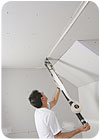
The next generation of drywall finishing tools invented was pneumatic (air) driven. These tools were assisted by air from a compressor to push the joint compound to the drywall. They decreased the physical strain on the user’s body and could generally allow a contractor to increase their production. Also, these tools became more versatile with many different applications being able to be performed with one set of tools. A finisher could tape, coat, spray textures and clean the tools at one workstation. With these tools, the finisher didn’t have to push the joint compound out of the tools with their back or shoulders-the air from an attached compressor did that for them.
It would be ideal if every finisher could just take the mud from the bucket to the wall without stopping. The latest drywall finishing tools to be invented was the continuous flow system. With this airless system, the finisher can take the joint compound from the bucket to the wall without having to go back to the pump to fill up. This finishing method gives a finisher a tremendous advantage since the finishing aspect of a drywall job can be completed with even less effort and increased efficiency over other tools in the industry. Using an airless painters pump with a submersible foot valve also allows contractors to paint, texture and apply a Level 5 finish. The airless pump can be attached to any brand, style boxes or coaters, thus increasing the efficiency of any brand of tools available in the industry. For paper taping the drywall, the continuous flow taper weighs only 12 pounds while in operation and the finisher only needs to stop when changing the roll of paper tape.
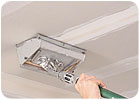
If you read this article, please circle number 325.
Sidebar: Drywall Historical Facts
Gypsum, the mineral that’s used to manufacture drywall, is one of the most commonly found minerals on earth. Its use in building and design dates back to the early Egyptians, who utilized gypsum for making urns and vases and constructing royal tombs. The ancient Greeks and Romans also used gypsum plaster as a building material.Gypsum was used as a soil nutrient throughout Europe for centuries and, beginning in the late 1700s, in the U.S. Today, gypsum not only conditions soil and prevents salt damage to lawns but is also used in a wide range of agricultural applications.
For example, mushrooms sold in supermarkets are grown in gypsum-fortified compost beds that help cultivate the aerobic bacteria mushrooms require. When added as a fertilizer, gypsum ensures that peanut plants receive enough calcium to develop normal kernels.
In addition, gypsum, which is classified as “safe” for use in foods and pharmaceuticals by the Food and Drug Administration, is commonly used as an additive in pharmaceuticals, foods and beverages. The average person ingests 28 pounds of gypsum throughout the course of his or her lifetime in consuming such items as hamburger rolls, beer, analgesic tablets, spaghetti and vitamin pills.
But gypsum’s primary application today is wallboard. Its use in modern-day drywall actually began in 1917, when United States Gypsum Co. patented the Sheetrock brand name. The gypsum panel was actually an improved and upgraded version of Sackett Plaster Board.
Developed around the turn of the 20th century, Sackett Board was a laminated sheet of plaster used for packing cases. The early versions of the product consisted of multiple layers of paper and plaster. The edges of the 1/4-inch-thick panels tended to crumble easily and the rough paper surface of the panel did not provide a satisfactory finished wall.
Residential and commercial drywall applications grew throughout the ’20s and ’30s but it wasn’t until the 1940s that the product came of age. During World War II, millions of square feet of wallboard were used in constructing military bases and facilities.
Following World War II, demand for drywall skyrocketed as builders searched for ways to meet the huge demand for cost-efficient housing. Because drywall enabled builders to complete interior walls much more economically than traditional plaster, it quickly became the choice for interior wall construction.
By 1960, the gypsum industry was producing nearly 8 billion square feet of drywall annually. Usage of drywall has continued to grow over the past decades, and the industry currently produces about 30 billion square feet annually.
Synthetic gypsum has exactly the same chemical makeup, performance and handling characteristics as natural gypsum rock.
